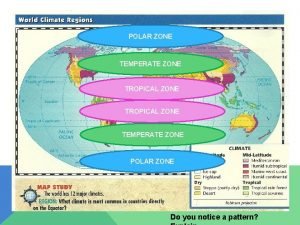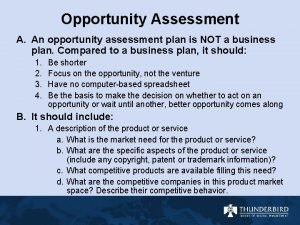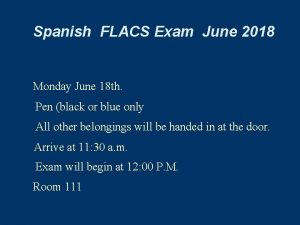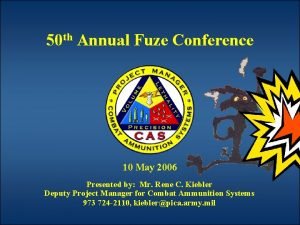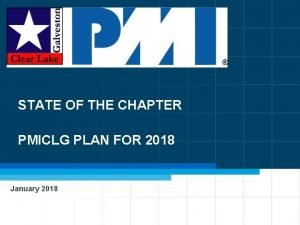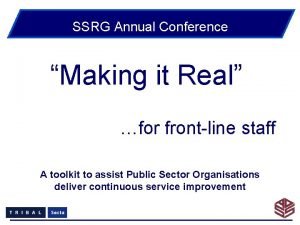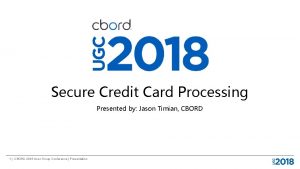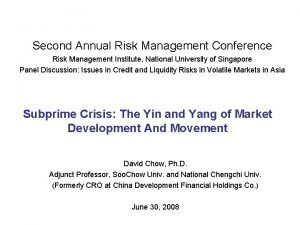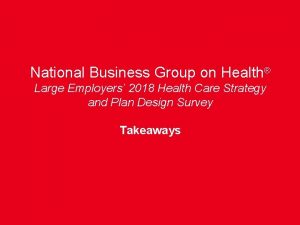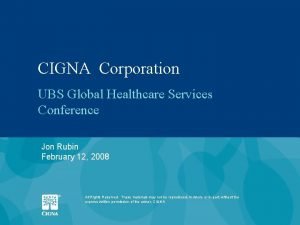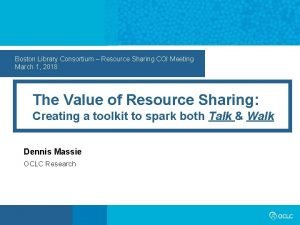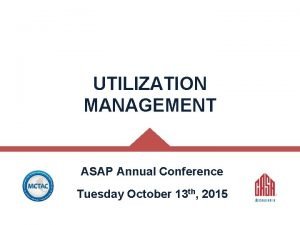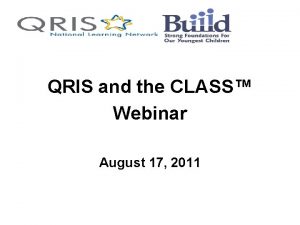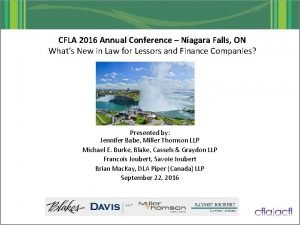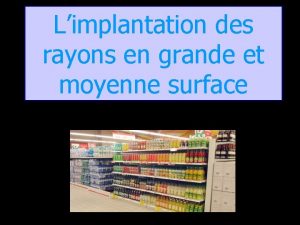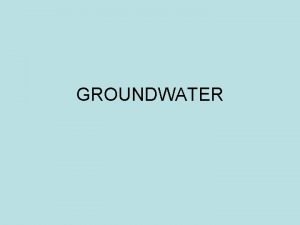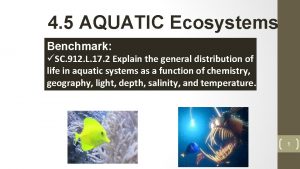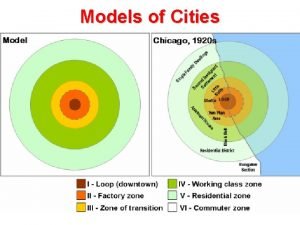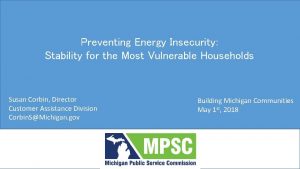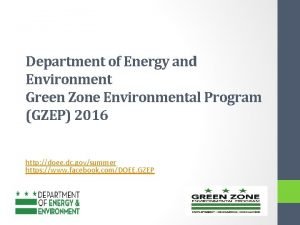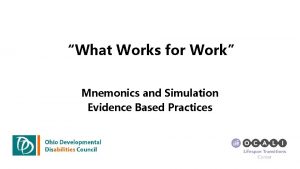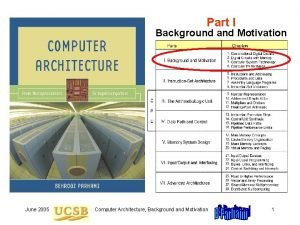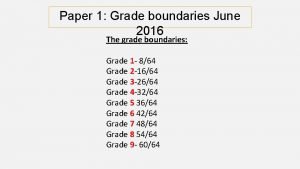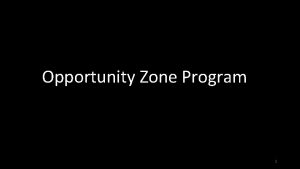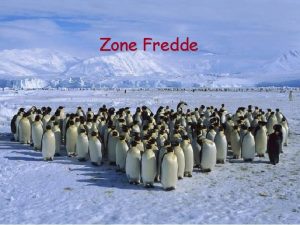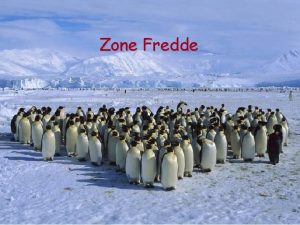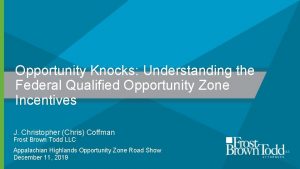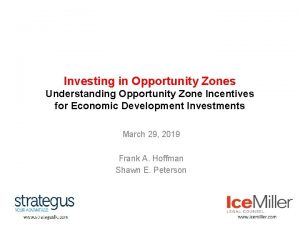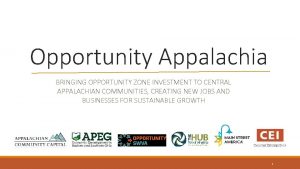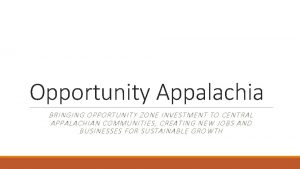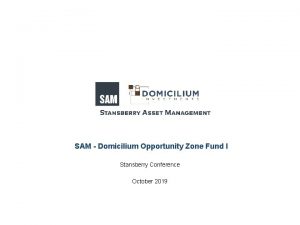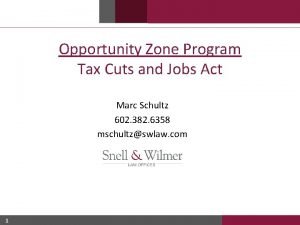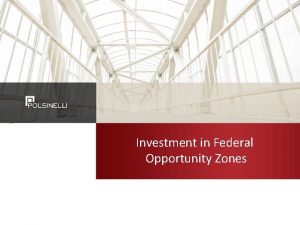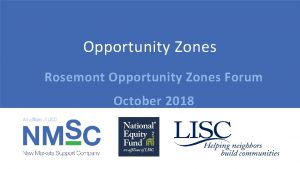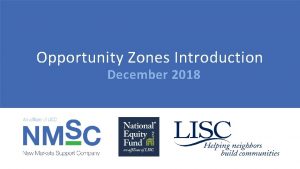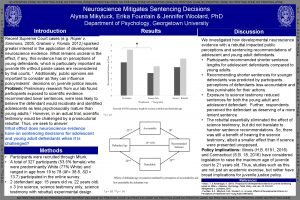Opportunity Zone Program Conference June 28 2018 History


















































- Slides: 50

Opportunity Zone Program Conference June 28, 2018 History Colorado Center 1200 North Broadway Denver, Colorado 80203 1

Opportunity Zone Program Conference PANELISTS Kenan Fikri Steven F. Mount Marc L. Schultz Economic Innovation Group Squire Patton Boggs Snell & Wilmer This slide presentation is based in part on a presentation prepared by John Sciarretti, Novogradac & Company LLP, and is used with his permission. Novogradac & Company LLP is a national accounting firm with broad expertise in the Opportunity Zone program and in many tax credit programs. 2

Opportunity Zone Program Introduction • • • History and Status of Opportunity Zone Program Benefits of the Opportunity Zone Program Tax Incentives Qualified Opportunity Zones – Qualification and Status Qualified Opportunity Funds – What are the rules, how do you qualify? Direct and indirect investment in Qualified Opportunity Zone Business Property Readily Identifiable Investment Types in Opportunity Zones Combining Opportunity Zone Program with Other Tax Incentives Regulatory Guidance Needed Questions and Answers 3

Opportunity Zone Program Overview Kenan Fikri, ECONOMIC INNOVATION GROUP / Washington, DC / @kenanfikri 4

52 million Americans (1 in 6) live in economically distressed communities. Nearly 400, 000 Coloradoans live in economically distressed zip codes. Prosperous Distressed Source: EIG’s “Distressed Communities Index” 5

Today’s struggling communities have been completely sidelined by 21 st century economic growth. Cumulative change in employment by quintile Change in employment from 2000 to 2015 by quintile Source: EIG’s “Escape Velocity” 6

Traditional modes of financing do ever less for non -prime businesses in non-prime communities. Nearly one out of every four community banks has disappeared since 2008 In real terms, small business lending remains down by a quarter 75% of all venture capital concentrates in three states $800 10, 000 Billions of 2009 dollars 8, 000 6, 000 4, 000 2, 000 $600 75% $400 $200 0 2005 2010 2015 $0 Number of U. S. Community Banks 1995 2016 Sources: FDIC and National Venture Capital Association 7

Access to mission-oriented capital is just as uneven. 27% of counties received no CDFI funding from 2011 to 2015 Even philanthropies and foundations bypass many of the country’s neediest communities 75% Sources: The Urban Institute and National Center for Responsive Philanthropy 8

The idea has strong, bipartisan roots and builds on the lessons from prior federal efforts to revitalize struggling communities. 9

What makes Opportunity Zones so unique? • It is an investor incentive that pertains exclusively to capital gains. • It is designed to concentrate capital rather than diffuse it. • It rewards patient capital: All incentives are tied to the longevity of the investment. • It unlocks scarce equity capital. • It provides no up-front subsidy and doesn’t pick winners. • It can move at the speed of the market. • It was designed with startups in mind. • It gives investors a stake in communities’ future: Most programs reward individual projects; this one ties investor payoff to community success. 10

What makes Opportunity Zones so promising? Flexibility: Low-income communities have a wide range of financing needs. The flexibility of the incentive provides the potential to support a variety mutually reinforcing activities within a single community as well as across a broad spectrum of communities. Scalability: There is no statutory cap on the amount of capital that can flow to Opportunity Zones in any given year. As such, Opportunity Zones have the potential to help fuel economic renewal in distressed communities on an unprecedented scale. Simplicity: Complexity has often been the Achilles heel of policies aimed at unlocking private capital in low-income areas. Complexity adds cost, time, and risk to business transactions, biasing programs towards a narrower set of stakeholders and more risk-averse outcomes, often precluding the very types of business investments that are most likely to have transformative benefits for communities. 11

There are three core elements to the program. Zones: States and territories designated up to 25 percent of Low-Income Community Census tracts in their state to be certified by Treasury as Opportunity Zones. Funds: Opportunity Funds are self-certified investment vehicles organized as corporations or partnerships for the purpose of investing in qualified Opportunity Zone assets. All investments that seek to take advantage of the provision must flow through Funds. Investments: Funds make equity investments into businesses and property in Opportunity Zones. Qualified assets are the stocks of qualified companies, interests of qualified partnerships, or direct ownership of qualifying tangible property. 12

Visit eig. org/opportunityzones for more information EIG brings together leading entrepreneurs, investors, economists, and policymakers from across the political spectrum to address America’s economic challenges. WEB eig. org EMAIL kenan@eig. org facebook. com/Economic. Innovation. Group linkedin. com/company/economic-innovation-group twitter. com/Innovate. Economy Disclaimer: This document is provided by the Economic Innovation Group for informational and educational purposes only. It is not intended to constitute legal or professional advice and should not be relied upon or treated as a substitute for consultations with professional, legal, or other competent advisers. 13

Benefits of the Opportunity Zone Incentive 14

Taxpayers can get capital gains tax deferral (& more) for making timely investments in Qualified Opportunity Funds which invest in Qualified Opportunity Zone Property 15

3 Tax Incentive Benefits 1. Gain Deferral 2. Partial forgiveness 3. Forgiveness of additional gains 16

Period of Deferral The period of capital gain tax deferral ends upon the earlier of: Dec. 31, 2026, or… EARLIER SALE 2018 2019 2020 2021 2022 2023 2024 2025 2026 2027 2028 17

Amount Recognized THE LESSER OF: 1. Amount of gain deferred or 2. The fair market value of investment in Qualified Opportunity Fund interest MINUS: Taxpayer’s basis in the Qualified Opportunity Fund interest Note: The taxpayer’s basis in the Opportunity Fund is initially deemed to be zero. 18

Partial Forgiveness and Forgiveness of Additional Gains Basis is equal to Fair Market Value SALE INVESTMENT HELD FOR 5 YEARS 2018 2019 2020 2021 Basis increased by 10% of the deferred gain Basis increased by 5% of the deferred gain Up to 90% taxed Up to 85% taxed HELD FOR 7 YEARS 2022 2023 2024 2025 Forgiveness of gains on appreciation of investment Requires an election HELD FOR 10 YEARS 2026 2027 2028 19

Jan. 2, 2018 Taxpayer enters into a sale that generates $1 M of capital gain June 30, 2018 (Within 180 days), Taxpayer contributes entire $1 M of capital gain to a Qualified Opportunity Fund 2018 2019 • • Taxpayer is deemed to have a $0 basis in its Qualified Opportunity Fund investment Qualified Opportunity Fund Invests the $1 MM in Qualified Opportunity Zone Property 2020 2021 2022 2023 20

June 30, 2023 (After 5 years), Taxpayer’s basis in investment in QOF increases from $0 to $100 k 2023 2024 June 30, 2025 (After 7 years), Taxpayer’s basis in investment in Qualified Opportunity Fund increases from $100 k to $150 k 2025 2026 Dec. 31, 2026 $850 K of the 1 MM of deferred capital gains are taxed and the basis in QOF investment increases to $1 MM. 2027 June 30, 2028 (after 10 years) , Taxpayer sells its investment for $2. 0 MM. Basis in the investment is deemed to be FMV. The effect is no tax on appreciation in investment. 2028 21

Opportunity Zone Incremental Benefit Standard After Tax IRR Total IRR 10. 00% 9. 08% 9. 00% 8. 00% 7. 00% 8. 08% 7. 95% 7. 71% 6. 00% 4 Year 5 Year 7 Year 12/31/2026 10 Year 7. 44% 6. 00% 5. 00% 4. 00% 3. 00% 2. 00% 1. 00% 0. 00% 23. 8% Tax Rate Standard After Tax IRR Incremental Opportunity Zone Benefit Opportunity Zone Investment IRR Percentage Increase 4 Year 6. 00% 5 Year 6. 00% 7 Year 6. 00% 12/31/2026 6. 00% 10 Year 6. 00% 1. 44% 2. 08% 1. 95% 1. 71% 3. 08% 7. 44 8. 08% 35% 7. 95% 32% 7. 71% 29% 9. 08% 51% 22

Perishability of Incentives 3. 50% 3. 08% 3. 00% 2. 96% 2. 74% 2. 61% Incremental IRR 2. 50% 2. 25% 2. 09% 2. 00% 1. 91% 1. 74% 1. 50% 1. 00% 0. 50% 0. 00% 2018 2019 2020 2021 2022 2023 2024 2025 Year of Qualified Opportunity Fund Initial Investment 23

State Tax Implications • Opportunity Zone benefits increase if states conform to the Federal Law • Some states piggy-back off of the current Federal Law but could decouple from opportunity zones • New York decided not to decouple • Hawaii decided to decouple • Some states do not conform to Federal Law but could add opportunity zones at the state level • Colorado is considering a bill to add the opportunity zone benefit at the state level • Some states do not have a state income tax (e. g. Alaska, Florida, Nevada, South Dakota, Texas, Washington, and Wyoming). • State Tax Implications of an single opportunity zone transaction may include multiple states • State where original gain was realized • State (s) where the opportunity fund has nexus • Some states are tying other State incentives to opportunity zones • Missouri proposed increased cap for state historic credits for properties in opportunity zones • California introduced a bill to exempt projects in opportunity zones from the CA Environmental Quality Act 24

Where are the Opportunity Zones? 25

Colorado’s Opportunity Zones 126 census tracts choosecolorado. com/oz For a list and maps of all opportunity zones nationwide go to: https: //www. cdfifund. gov/Pages/Opportunity-Zones. aspx 26

BREAKDOWN OF PROPOSED TRACTS BY ENTERPRISE ZONE REGION (% OF TOTAL PROPOSED TRACTS) 126 Proposed Tracts 27

CO ZONES PROVIDE A DIVERSE PORTFOLIO FOR INVESTORS 28

Designated Opportunity Zones and Public Housing Developments Designated Opportunity Zones and Renewal Communities Designated Opportunity Zones and Empowerment Zones 29

Designated Opportunity Zones and Enterprise Communities Designated Opportunity Zones and Enterprise Zones Designated Opportunity Zones and Promise Zones 30

Qualified Opportunity Zones remain in effect through December 31, 2028 31

Qualified Opportunity Fund 32

Qualified Opportunity Fund Statutory Requirements • Corporation or Partnership • Purpose • Assets Test* Certification Process Noncompliance Penalty 33

Qualified Opportunity Fund - Purpose An investment vehicle organized as a corporation or a partnership for the purpose of investing in Qualified Opportunity Zone Property. 34

Qualified Opportunity Fund – Assets Test Must hold at least 90% of assets in Qualified Opportunity Zone Property, determined by the average of the percentage of Qualified Opportunity Zone Property held on: The last day of the first six month period of the fund’s taxable year, and The last day of the fund’s taxable year June 30 th JAN FEB MAR APR MAY JUN December 31 st JUL AUG SEPT OCT NOV DEC 35

Certification Process • An eligible taxpayer self-certifies to become a certified qualified opportunity fund. • No approval or action by the IRS is required. • A taxpayer merely completes a form (which will be released in the summer of 2018) and attaches that form to the taxpayer’s federal income tax return for the taxable year. • The return must be filed timely, taking extensions into account. 36

Certification Process • IRS announces self-certification process for Qualified Opportunity Funds on April 24 • Self-certification form to be attached to tax return • Form to be published summer 2018 37

Qualified Opportunity Fund – Noncompliance Penalty Failure to meet 90% investment standard Per month penalty for failing to meet 90% test x % shortfall underpayment rate penalty No penalty if it is shown failure is due to reasonable cause (Federal short-term rate plus 3%) – currently 5% 38

Qualified Opportunity Zone Property Qualified Opportunity Zone Partnership Interest (Qualified Opportunity Zone Business) Qualified Opportunity Zone Stock (Qualified Opportunity Zone Business) Qualified Opportunity Zone Business Property 39

Qualified Opportunity Zone Stock and Partnership Interests • The investment must be acquired after December 31, 2017 in exchange for cash; • Must be a qualified opportunity zone business, or is being organized for the purpose of being a qualified opportunity zone business; • Must remain a qualified opportunity zone business for substantially all of the qualified opportunity fund’s holding period 40

Qualified Opportunity Zone Businesses A trade or business in which substantially all of the tangible property owned or leased by the taxpayer is qualified opportunity zone business property and: At least 50% of income derived from Active Conduct Substantial portion of intangible property used in active conduct of business < 5 percent unadjusted basis of property is nonqualified financial property Tangible property that ceases to be qualified opportunity zone business property shall continue to be treated as such for 5 years or until no longer held (if earlier). 41

Excluded Businesses Can’t be a “Sin Business” A private or commercial golf course, country club, massage parlor, hot tub facility, suntan facility, racetrack or other facility used for gambling, or any store the principal business of which is the sale of alcoholic beverages for consumption off premises. 42

Qualified Opportunity Zone Business Property ü Tangible property used in a trade or business ü Acquired by purchase from an unrelated party (20% standard) after December 31, 2017 ü During substantially all of holding period, substantially all the use is in a Qualified Opportunity Zone ü Original use in the Qualified Opportunity Zone commences with the taxpayer OR ü Taxpayer substantially improves the property ü during any 30 -month period after acquisition, additions to basis exceed an amount equal to the adjusted basis of such property at the beginning of such period 43

Comparison of Requirements by Direct and Indirect Investment by Opportunity Fund Requirement Direct Investment Indirect Investment Percentage of Opportunity Fund’s assets that must be invested in qualified opportunity zone business property 90% N/A Percentage of Opportunity Fund’s assets that must be invested in stock or partnership interests N/A 90% Percentage of Opportunity Fund’s assets that may be held in cash or other liquid investments 10% 5% plus reasonable working capital Percentage of Opportunity Fund’s assets that may be held in intangible property 10% Unlimited, but intangible property must be used in trade or business Percentage of Opportunity Fund’s assets that must be invested in tangible property 90% No minimum Percentage of gross income that must be derived from Opportunity Zone None 50% Ineligible Businesses None Sin Businesses 44

Readily Identifiable Investment Types in Opportunity Zones Commercial Real Estate Development and Renovation in Opportunity Zones Opening New Businesses in Opportunity Zones Expansion of Existing Businesses into Opportunity Zones Large Expansions of Businesses already within Opportunity Zones 45

LIHTC 1031 Combining with Other Tax Incentives NMTC Opportunity Zone Program 1202 HTC RETC 46

Combining Opportunity Zones with Low Income Housing Credits • Investment holding periods line-up nicely • Basis limitations may suspend loss benefits unless debt basis • Appreciation not likely, but there may be an opportunity forgiveness of exit tax on excess loss benefits. • Substantial rehabilitation rules don’t line-up • LIHTC - $6, 000+/Unit • OZ – expenditures in excess of beginning basis over 30 months • Tax deferral payment likely less due to diminished FMV. 47

Combining Opportunity Zones with New Market Tax Credits • Investment holding periods do not line up with the 10 -year benefit. • CDE would need to obtain Opportunity Fund status. • QALICB and Qualified Opportunity Zone Business definitions have many similarities • QLICIs must be equity under Opportunity Zone • May need CDFI Fund approval to change product strategy • Equity QLICIs could affect reasonable expectation safe harbor • Deferral election may be limited as NMTC investors will need basis to take required NMTC basis deduction • Tax deferral payment in 2026 could be less due to diminished FMV. 48

Combining Opportunity Zones with Investment Tax Credits (RETC/HTC) • Investment holding periods do not line up with the 10 -year benefit. • Basis limitations may suspend credits/ loss benefits unless debt basis • Appreciation not likely, but there may be an opportunity forgiveness of exit tax on excess loss benefits. • For Pass-through structures- Master tenant would need to be the Opportunity Fund Otherwise NQFP issues with investment in Landlord • Tax deferral payment in 2026 could be less due to diminished FMV. 49

Regulatory Guidance Needed from IRS • Grace periods for Opportunity Fund and Opportunity Zone Business To make investments • Safe harbors permitting cash to be held for sufficient periods to construct or improve property • Clarification of the investor when a partnership recognizes a gain • Basis for applying various tests, i. e. adjusted tax basis or FMV • Meaning of “substantially all” and “substantial portion” • Clarification of “original use” requirement especially with respect to vacant land 50
 Novogradac opportunity zone conference
Novogradac opportunity zone conference Polar tropical
Polar tropical Intertidal zone neritic zone and oceanic zone
Intertidal zone neritic zone and oceanic zone Source zone transition zone and floodplain zone
Source zone transition zone and floodplain zone Opportunity assessment plan example
Opportunity assessment plan example Flacs checkpoint b spanish exam june 2018 answers
Flacs checkpoint b spanish exam june 2018 answers Geometry regents 2019
Geometry regents 2019 Flacs checkpoint b spanish exam june 2016 answers
Flacs checkpoint b spanish exam june 2016 answers Cxccxc results 2018
Cxccxc results 2018 January 2017 chemistry regents answers
January 2017 chemistry regents answers Opportunity zone
Opportunity zone Que letra continua m v t m j
Que letra continua m v t m j Gartner bi summit 2016
Gartner bi summit 2016 Annual fuze conference
Annual fuze conference Cmaa conference 2018
Cmaa conference 2018 Asha convention hotels 2018
Asha convention hotels 2018 Workforce planning conference 2018
Workforce planning conference 2018 Lifelong learning conference 2018
Lifelong learning conference 2018 Pmi houston conference 2018
Pmi houston conference 2018 Adss conference 2018
Adss conference 2018 Freedom pay credit card processing
Freedom pay credit card processing Financial risk management conference 2018
Financial risk management conference 2018 National business group on health conference 2018
National business group on health conference 2018 Pfa conference 2018
Pfa conference 2018 Cigna conference 2018
Cigna conference 2018 Aatb conference 2018
Aatb conference 2018 Eacs conference 2018
Eacs conference 2018 Locadtr
Locadtr Interact conference 2018 teachstone
Interact conference 2018 teachstone Bccie summer conference 2018
Bccie summer conference 2018 Tlffra conference 2018
Tlffra conference 2018 Cfla conference 2018
Cfla conference 2018 Respiratory zone and conducting zone
Respiratory zone and conducting zone Conducting zone respiratory
Conducting zone respiratory Zone froide zone chaude magasin
Zone froide zone chaude magasin Water table chart
Water table chart Zone of aeration and zone of saturation
Zone of aeration and zone of saturation Limnetic zone
Limnetic zone Photic zone and aphotic zone venn diagram
Photic zone and aphotic zone venn diagram Conducting zone vs respiratory zone
Conducting zone vs respiratory zone Zone 1 and zone 2
Zone 1 and zone 2 Concentric zone
Concentric zone 2018 dbq ap world
2018 dbq ap world Www dte lsp com
Www dte lsp com Contoh program kerja omk 2018
Contoh program kerja omk 2018 Green zone environmental program
Green zone environmental program 30 days has september
30 days has september June 2010 physics regents answers
June 2010 physics regents answers June 2005 calendar
June 2005 calendar The skin cracks like a pod
The skin cracks like a pod Good morning 1 june
Good morning 1 june

